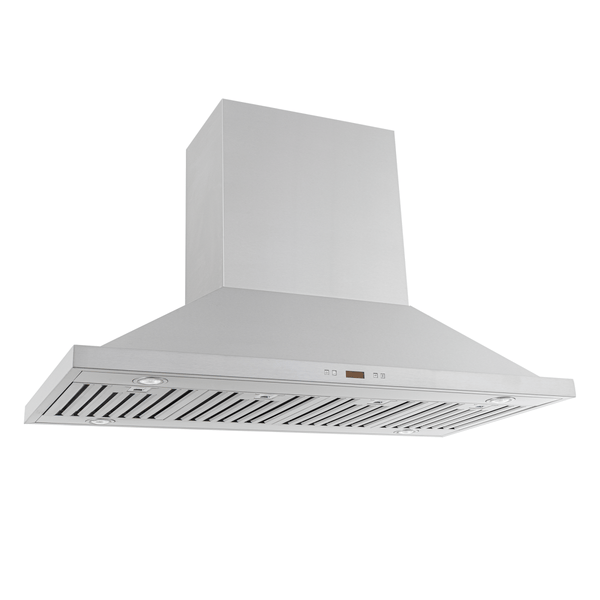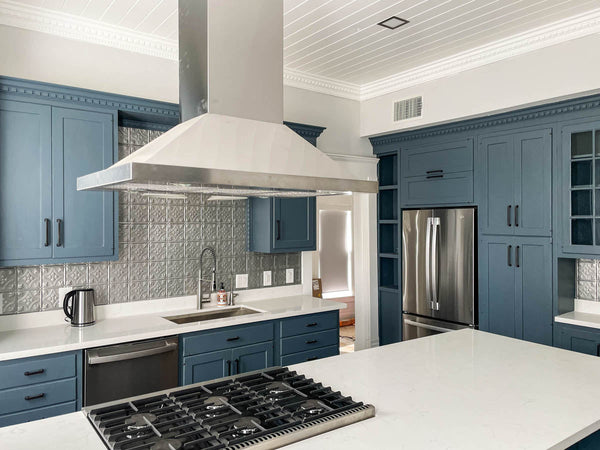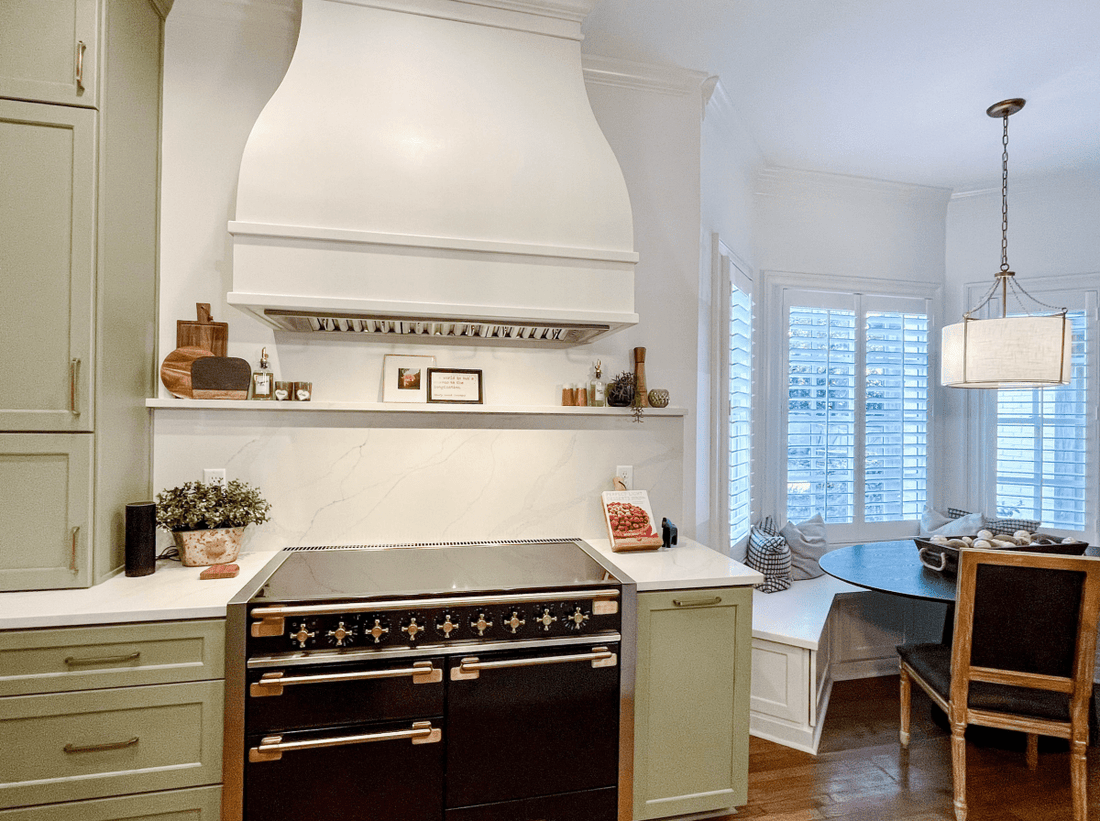Table of Contents
Introduction
A range hood insert is a beautiful addition to your home. It is the perfect companion for your custom hood. Unlike a range hood, your insert will be concealed from view. You'll see this quite often in today's homes. People love a sleek, clean, beautiful kitchen.
To keep your air clean and fresh (and keep that pesky grease off your custom hood), you'll need a range hood insert.
We'll show you exactly how to choose the perfect range hood insert for your kitchen.
How Do I Choose a Range Hood Insert?
As you shop for a range hood insert, it's important to consider the size, ducting, CFM, noise level, lights, and the type of blower.
1. Size
First, find the right size for your insert. You'll need to measure the width of your kitchen range.
The most common unit is inches but you can measure using whatever unit you like. Just make sure that you use the same units to measure your insert and your range.
Let's say you have a 36" kitchen range. Typically, you'll take that distance and subtract two inches. So you'll want a 34" insert for your 36" range. The two inches give the insert a little room to breathe so it's not cramped or forced into a small space. Now you also have the room to build your custom hood with lips or brackets to support the insert.
One exception to this rule is if you want to buy an insert that's one size larger than your range. If you do a lot of frying, barbecuing, or Asian cooking, and have the space to consider a larger insert. It will give you great coverage of your cooktop.
Here's an example, with a 36" range, you would want a 40" insert.
Common insert sizes are as follows: 28", 34", 40", 46", 52", and 58".
To learn more about range hood size, here.
2. Ducted or Ductless?
Next, you need to decide if you want a ducted or ductless insert. Don't make this part too complicated; in fact, it should be a pretty easy decision.
Not only is it highly recommended to buy a ducted insert, but they're also the most popular.
Especially if you put a lot of effort into your custom hood, you want to keep the grease, grime, and food particles off of it. A ducted range hood will move all the greasy air to the outside. So, your kitchen air will be cleaner compared to using a ductless insert.
3. CFM
CFM, or cubic feet per minute, measures the amount of air that a range hood moves. Generally, the more often you cook, the higher the CFM you'll need. For those who don't cook often, we recommend a 600 CFM range hood insert. If you cook often or enjoy Asian cooking or frying, we recommend a 1200+ CFM insert.
For avid cooks, we have a 1700 CFM blower option from our ProV series, which you can here.
To learn more about finding the CFM you need for your hood, check out our complete guide.
4. Noise Level (Sones)
You'll also want to consider the noise level of your hood. Noise level or sones go hand-in-hand with CFM.
Generally, the higher the CFM, the louder the hood. It depends on the quality of the hood.
If a low CFM hood is built with a cheap motor, it could be noisier than a hood with a higher CFM.
This might not be a big priority for you, but if it is, look for the sones rating on the product page. Or ask the manufacturer for the sone level of the range hood. They'll be able to tell you how loud it is. Also, look for a spec sheet on the site; most spec sheets will tell you the sone rating.
You've never heard of sones? Learn more about this measurement of noise right here.
To compare it with a more familiar sound measurement, decibels, click on this link
5. Lights
Lights won't make or break your decision on an insert. But if you have a preference, it's good to know your options. Most inserts use either LED or Halogen lights. LEDs are the most long-lasting and energy-efficient.
You might also find some hoods that feature dimmable lights. For example, Proline’s ProV series features dimmable Halogens. Dimmable lights are a convenient feature allowing you to adjust the lighting exactly how you want.
If You Didn't Know: Can I use an LED bulb in my range hood?
6. Inline or Local Blower?
Depending on the manufacturer, you'll also have the option between a local blower and an inline blower. A local blower sits inside the range hood while an inline blower sits inside the ductwork. Local blowers are closer to your kitchen, so they tend to be louder.
Most inserts will feature local blowers, but inserts with an inline blower are available on the market.
How Do You Measure for a Range Hood Insert?
First, you have to determine where your insert will slide inside your custom hood. Typically, range hoods extend from the back of your range to about the middle of your front burners, but some may extend further.
As far as mounting it goes, use a plumb line and a ruler to mark where you will cut the hole for the custom hood. I would not cut the hole for your hood before you receive the hood. Otherwise, you run the risk of cutting the hole too large.
Take your insert out of the packaging and measure the width and length of the insert. Cross-check these lengths with the lengths in the manufacturer's spec sheet just as a sanity check.
If you're not 100% confident in your measurements, cut the hole a half-inch smaller on all sides. You can try to slide your insert into the custom hood and see exactly how much larger the hole needs to be.
Once you've done your measurements and cut the hole, it's time to install the insert. Head on over to our step-by-step guide to learn more.
Range Hood Insert Reviews
Check out three of the best range hood inserts on the market at this link. We include a description, features table, customer reviews, and much more.
Comparisons: Insert vs Other Range Hood Types
Range Hood Insert vs Under Cabinet Range Hood
A range hood insert fits inside a custom hood whereas an under cabinet range hood fits under your kitchen cabinets. Range hood inserts are concealed from view whereas under cabinet hoods are not.

Range Hood Insert vs Wall Mount Range Hood
A range hood insert fits inside a custom hood, while a wall mount hood mounts on the wall. Most wall hoods can be rectangular, glass front, or tapered. But inserts don't have the stainless steel housing or the "hood."
Recap
We hope you enjoyed this complete range hood insert buyer's guide. Remember to consider six things when shopping for your insert:
- Size
- Ducted or Ductless?
- CFM
- Noise Level (Sones)
- Lights
- Inline or Local Blower?
To learn more about range hood inserts, check out the links below.
Related Articles
3 Best Range Hood Inserts from Proline
How to Install a Range Hood Insert
Ready to find the perfect range hood insert for your custom kitchen? Explore our complete collection and discover which insert best suits your cooking needs and design vision.
Shop Range Hood Inserts














